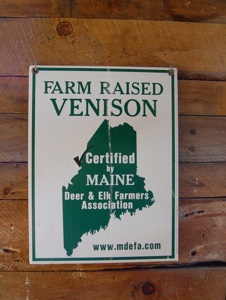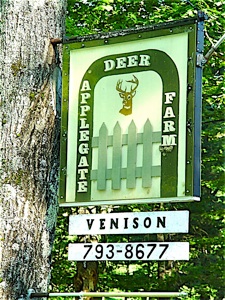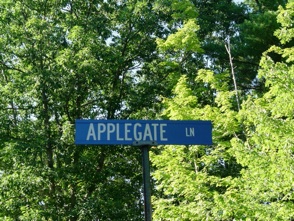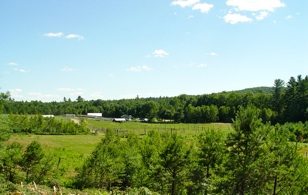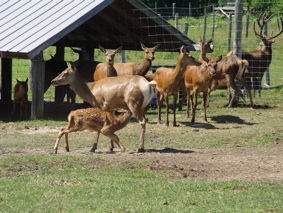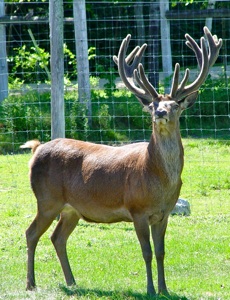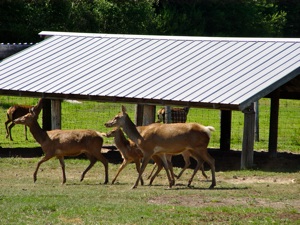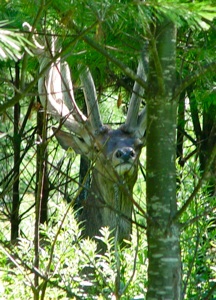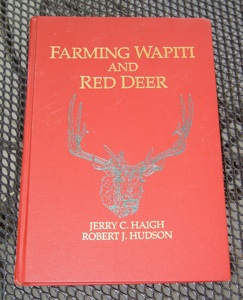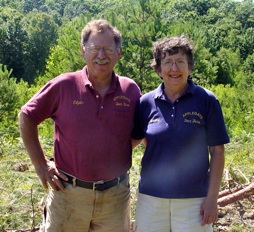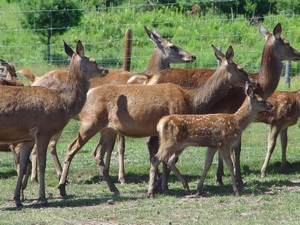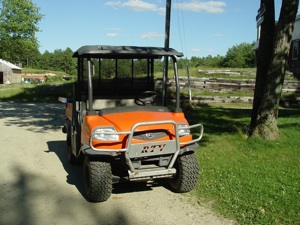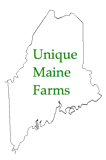What Makes Applegate Deer Farm So Unique?
The number of deer farms in Maine has
dramatically declined over the years and an
individual might have to travel quite a distance
before they had the opportunity to visit one.
The Applegate Deer Farm is tucked away
down a country lane at the foot of Mirror Lake
in sleepy little Newfield, Maine.
Applegate Deer Farm was asked to be a part
of this website project because it was believed
that running a red deer farm was in itself a rather
unique undertaking. There is no question that
the red deer operation of Edgar and Patricia
Dolbec is quite distinctive. A major portion of the success of their farm originates with the sale of the velvet harvested from the antlers of the deer.
After spending an afternoon on the Dolbec’s farm, the sight of the red deer definitely catches one's attention, but even more impressive is the
unbelievable resourcefulness of Patricia and
Edgar Dolbec in running their farm operation.
When early on in their farm career, the Dolbecs
discovered that their fuel bill for operating the
farm equipment, heating their buildings, and driving their cars exceeded five thousand dollars, they knew something had to change. It was then that, thanks to the assistance of Norman Layne, they turned to the world of bio-diesel and waste vegetable oil. Their cars (1981 Volkswagon, 2002 Ford F-450, and 2005 Jeep Liberty CRD) and their farm equipment now run on bio-diesel. Their home and outbuildings are heated with waste vegetable oil.
In the beginning days of Applegate Deer Farm,
the red deer were fed grain and oats and corn in
addition to the hay. As their herd built up and
feed costs soared, the Dolbecs once again knew
it was time to look to alternatives.
Their red deer are now fed with the brewers spent
grain generously given to them by Sebago
Brewing Company. Once a week Edgar drives his Ford F-450 pickup with the attached dump trailer and fills the trailer with the brewers grain. This grain is the waste matter that is created from the residue of malt and grain which remains in the mash kettle after the mashing and lautering process takes place. It is composed of 21 percent protein. Sebago Brewing needed an outlet in which to place the brewers grain that needed to be removed from their facility and the Dolbecs were in need of a more affordable feed. The relationship that has formed between the brewery and the deer farm is a great example of successful re-purposing of farm products.
When Edgar Dolbec retired early from his structural technician job at Portsmouth Naval Shipyard in 1999, he and Patricia knew that they wanted to pursue some agricultural enterprise. They had purchased one hundred acres adjacent to their home in 1985. Their decision to raise red deer was based on a year of research. After visiting all types of farms - dairy, sheep, and other livestock, they concluded that raising deer would be the best fit. According to Edgar, in 1999, the United States was importing eighty-five percent of venison. The Dolbecs felt that red deer would prove to be a wise choice because of the promising market and the relatively easier demands of care for red deer in comparison to other forms of livestock.
Where dairy animals require a high level of
commitment and time, the red deer can survive
quite well by their own means. In the thirteen
years that they have been raising red deer, the Dolbecs have rarely seen the birth of a fawn. The hind (female red deer) normally delivers their young in the tall grasses along the fence line. They do not require assistance. In comparison to other livestock, red deer have fewer health challenges and threats from disease.
With help from many other deer farmers in Maine
and New Hampshire and some advice from the Maine Deer and Elk Association, the Dolbecs decided to give red deer a try. The book Farming Wapiti and Red Deer by Jerry Haigh and Robert Hudson has proven invaluable.
The initial start-up costs for a deer farm are quite high. The fencing requirements are costly and shelters are required by the Maine Department of Agriculture. The time involved and the costs for purchasing hay equipment can be challenging to handle.
With the purchase of one stag and six mature female red deer, the Dolbec’s herd was started in 1999. The number in their herd built up to 140 deer at one time. The market declined and they are raising 30 deer at this time - 14 female, 12 fawns, and four stags. Their venison is sold at corner stores in Waterville and Hollis. McDougal’s Orchard carries their meat in the fall. Their venison is also enjoyed, along with pheasant, duck, trout, deer, and moose at the Wildlife Harvest celebration at Unity College in the fall.
While the Dolbecs raise the deer on their property, the slaughtering process takes place at the Windham Butcher Shop, a USDA processor, and the antlers are harvested at a USFDA removing plant in Mapleton, Maine.
The harvesting of the velvet antlers of the red deer is the part of the Dolbec’s red deer operation that results in their biggest return. Velvet antler or the immature antler of deer has been highly regarded as a medicine and source of improving health for thousands of years. In traditional Chinese medicine the velvet antler is used to supplement the Yang and is recommended to treat a whole range of issues including lower back pain, weak pulse, depression, and exhaustion.
The deer’s velvet antler is sold by the Dolbecs in pill form. The Dolbecs have a handling building with various gates and holding areas where the deer are led when it is time to harvest the antlers. The deer are sedated and the antlers are removed by the Dolbecs with saws. The antlers are frozen and transported to Mapleton, Maine, where Darrell “Butch” Tobin grinds them into capsules which are highly prized in the Asian markets and throughout the world. Since red deer grow new antlers each year the harvest takes place on an annual basis each spring.
Raising deer has its definite advantages. The commitment of time and feed is much less than other livestock but there are major investments with the price and labor involved with the
extensive system of fencing that is required.
Red deer appear somewhat docile creatures when they are observed while grazing or relaxing under a shelter. The stags can run upwards of 600 pounds and when rut season takes place they can turn into “another type of animal.” Hinds who are nursing can also become quite aggressive. Edgar related a story of a Maine farmer who almost died when he encountered an “ugly” stag, Edgar explained that the farmer was fortunate to have suffered only from a broken leg after the animal attacking him was shot. One of Edgar and Patricia’s stags attacked their tractor repeatedly and punctured the rear tire
a few years ago.
The Dolbecs lost a fawn to a bear and great precautions have had to be taken to keep other predators away. If a deer runs into a porcupine and kicks one in defense, they become disabled due to all the quills that have become embedded in their feet. The Dolbecs are forced to sedate the animal to remove the quills.
When asked if any of their four children (Celeste, Evan, Greg, Colleen) have taken an interest in the deer farming, Edgar immediately responded with the comment, “They have been smart enough to stay out of it!”
But, the Dolbecs are persevering. They are in the process of building another paddock that will increase the grazing area to a total of fifteen acres. Although the Maine Deer and Elk Farmers Association marketing plan never really materialized and some red deer farmers have opted to open hunting preserves, the Dolbecs are resolved to continue to dedicate their efforts to the expansion and improvement of their red deer farm. They are hoping to increase their venison and antler sales.



